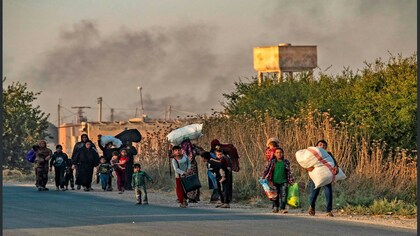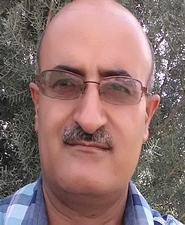Middle East on the brink of war
18:54 - 3 January 2012

As Syrian dictator Bashar al-Assad clings to power with the quiet backing of regional powers Iran and Russia, the Middle East may be sliding slowly into war.
Squeezed between the rebellions of a bloody Arab Spring and growing fears of a possible military response to Iran’s growing nuclear threat, the region is becoming increasingly unstable.
“I would be very surprised if it turned into a Russian-American war, but this could be a Mid-East war: Hezbollah, Hamas, Iran, Syria, Israel all having at each other,” said Jack Granatstein, military historian and senior research fellow at the Canadian Defence and Foreign Affairs Institute.
Ramazan Gözen, an international relations expert at Abant İzzet Baysal University wrote this week in the Turkish newspaper Zaman, “A process of steadily sharpening polarization is being experienced … it does not bode well…. In short, the polarization over Syria and Iran can turn into an uncontrollable conflict between the polarized countries and their supporters.”
Russia and the United States are bracing for a naval confrontation, unprecedented since the Cold War, in the eastern Mediterranean, just off the coast of Syria.
Iran, worried over a possible pre-emptive strike against its nuclear facilities, has threatened to attack NATO’s new missile defence shield in Turkey if it is attacked by either Israel or the United States. It has also said it will soon stage a navy drill to practise closing the Strait of Hormuz, through which 40% of the world’s oil travels.
Turkey’s Foreign Minister, Ahmet Davutoglu, has raised the possibility of a Turkish military incursion into Syria to create safety zones for refugees, if Mr. Assad doesn’t stop killing civilians.
Click on this image to see an interactive map of Syria that shows the locations of this week\'s major events.
Syria responded last weekend by staging a massive live-fire military exercise, near the north-central desert town of Palmyra, that, according to Syrian state TV, was designed to test “the capabilities and readiness of missile systems to respond to any possible aggression.”
On Tuesday, under the headline “U.S. troops surround Syria on the eve of invasion?” the online Russian news channel RT.com reported U.S. troops withdrawn from Iraq are secretly being transferred to northern Jordan and taking up positions opposite Syrian tank formations along the border.
There have been reports NATO forces in Turkey may be training Syrian dissidents, while also helping prepare Turkish troops for any possible military intervention.
The headquarters of NATO’s air command for southern Europe has been located in Izmir Air Base, 320 kilometres southwest of Istanbul, since 2004. Turkey, the only Muslim member of NATO, hosts up to 24 major NATO bases on its territory and went to the brink of war with Syria as recently as 1998 in a dispute over Syria’s support for Kurdish terrorist attacks inside Turkey.
As tensions have increased between the two countries, with Turkey cutting trade and imposing financial sanctions, Syria has infuriated Turkey by re-establishing relations with the separatist Kurdistan Workers’ Party (PKK).
But it is Russia, Syria’s main arms supplier and old Cold War ally, that has raised the stakes of any possible military confrontation.
Along with China, the Russians have repeatedly blocked UN Security Council action against Syria and sought to protect Mr. Assad’s regime from the type of UN resolution that allowed NATO troops to intervene in Libya and help depose dictator Muammar Gaddafi.
Recently, Russian diplomats met with Syrian opposition leaders in an unsuccessful attempt to persuade them to hold peace talks with the Syrian government. Russia has also tried to convince Mr. Assad to accept an Arab League plan to allow international observers into Syria.
On Tuesday, just as UN officials accused Syria of killing more than 5,000 people in the last nine months, Russia’s Foreign Minister, Sergei Lavrov, angrily accused the West of taking an “immoral” stance on Syria by punishing Mr. Assad, while refusing “to raise the pressure on the armed extremist flank of the opposition.”
Mr. Lavrov insisted Syrian dissidents are using a “Libyan scenario” as a template for regime change and are deliberately trying to provoke a humanitarian crisis in the hopes of triggering foreign intervention.
Russia has had strong ties with Syria since Soviet times, and supplies Damascus with most of its weapons. Syria is also Russia’s sole conduit for influence in the Middle East and provides Moscow with the only port its navy can use in the Mediterranean.
The port Tartus is rapidly becoming a focal point for a potential conflict. Russia sent three guided missile frigates, reportedly loaded with anti-aircraft and anti-ship missiles for Syria, there in late November.
In an echo of the Cold War, the Russian ships were briefly shadowed by the U.S. Navy’s nuclear aircraft carrier USS George H.W. Bush and its naval strike force.
Now, the U.S. Sixth Fleet is said to be cruising off the Syrian coast, awaiting the arrival of Russia’s only aircraft carrier, the Admiral Kuznetsov, which is scheduled to arrive in Tartus with a strike force of its own next week.
The flagship of the Russian fleet, accompanied by several destroyers, will rendezvous with the three Russian frigates and elements of Russia’s Black Sea fleet for exercises off the coast of Syria.
This unexpected show of Russian naval power, the most demonstrative since the fall of the Soviet Union, may be designed to reassure Syria of Moscow’s continued support. But it could also complicate any possible foreign intervention in Syria and serves as a warning to the United States and NATO that they won’t be able to duplicate the no-fly zone they established over Libya.
The arrival of the Russian navy off the coast of Syria may also be intended to reassure Iran of Moscow’s continued interest, just as it fears a possible attack by Israel or the United States.
“The fight in Syria today is two contests in one,” said Michael Doran of Washington’s Brookings Institute. “It is a struggle between Syrians over the nature of their government and society, but it is also a regional rivalry between Iran and its adversaries.
“Tehran and its allies are working very hard to ensure that Assad stays in power. If he falls, they will work equally hard to shape the new order in a way that protects their key security interests.”
Iran could soon begin sensitive atomic activities in an underground facility deep inside a mountain, diplomatic sources said on Wednesday
On Wednesday, the former U.S. Ambassador to the UN, John Bolton, suggested in a radio interview Russia may have helped Iran intercept and down a U.S. stealth spy drone last week.
He said there is speculation Iran recently bought an advanced Russian jamming and electronic warfare system known as Avtobaza, which could be used to hack into the drone’s controls.
Some analysts suggest Iran may offer to give the Russians and Chinese a peek at the downed drone’s advanced communications and surveillance equipment in exchange for diplomatic and military support and possible secret assistance with its nuclear and missile programs.
“With the United States pulling its troops out of Iraq and Syria’s Bashar al-Assad losing his grip on power, the Middle East may soon be in for its biggest power shift since the 2003 American-led invasion of Iraq,” said Paul Salem of the Carnegie Endowment for International Peace.
Source - National Post
Squeezed between the rebellions of a bloody Arab Spring and growing fears of a possible military response to Iran’s growing nuclear threat, the region is becoming increasingly unstable.
“I would be very surprised if it turned into a Russian-American war, but this could be a Mid-East war: Hezbollah, Hamas, Iran, Syria, Israel all having at each other,” said Jack Granatstein, military historian and senior research fellow at the Canadian Defence and Foreign Affairs Institute.
Ramazan Gözen, an international relations expert at Abant İzzet Baysal University wrote this week in the Turkish newspaper Zaman, “A process of steadily sharpening polarization is being experienced … it does not bode well…. In short, the polarization over Syria and Iran can turn into an uncontrollable conflict between the polarized countries and their supporters.”
Russia and the United States are bracing for a naval confrontation, unprecedented since the Cold War, in the eastern Mediterranean, just off the coast of Syria.
Iran, worried over a possible pre-emptive strike against its nuclear facilities, has threatened to attack NATO’s new missile defence shield in Turkey if it is attacked by either Israel or the United States. It has also said it will soon stage a navy drill to practise closing the Strait of Hormuz, through which 40% of the world’s oil travels.
Turkey’s Foreign Minister, Ahmet Davutoglu, has raised the possibility of a Turkish military incursion into Syria to create safety zones for refugees, if Mr. Assad doesn’t stop killing civilians.
Click on this image to see an interactive map of Syria that shows the locations of this week\'s major events.
Syria responded last weekend by staging a massive live-fire military exercise, near the north-central desert town of Palmyra, that, according to Syrian state TV, was designed to test “the capabilities and readiness of missile systems to respond to any possible aggression.”
On Tuesday, under the headline “U.S. troops surround Syria on the eve of invasion?” the online Russian news channel RT.com reported U.S. troops withdrawn from Iraq are secretly being transferred to northern Jordan and taking up positions opposite Syrian tank formations along the border.
There have been reports NATO forces in Turkey may be training Syrian dissidents, while also helping prepare Turkish troops for any possible military intervention.
The headquarters of NATO’s air command for southern Europe has been located in Izmir Air Base, 320 kilometres southwest of Istanbul, since 2004. Turkey, the only Muslim member of NATO, hosts up to 24 major NATO bases on its territory and went to the brink of war with Syria as recently as 1998 in a dispute over Syria’s support for Kurdish terrorist attacks inside Turkey.
As tensions have increased between the two countries, with Turkey cutting trade and imposing financial sanctions, Syria has infuriated Turkey by re-establishing relations with the separatist Kurdistan Workers’ Party (PKK).
But it is Russia, Syria’s main arms supplier and old Cold War ally, that has raised the stakes of any possible military confrontation.
Along with China, the Russians have repeatedly blocked UN Security Council action against Syria and sought to protect Mr. Assad’s regime from the type of UN resolution that allowed NATO troops to intervene in Libya and help depose dictator Muammar Gaddafi.
Recently, Russian diplomats met with Syrian opposition leaders in an unsuccessful attempt to persuade them to hold peace talks with the Syrian government. Russia has also tried to convince Mr. Assad to accept an Arab League plan to allow international observers into Syria.
On Tuesday, just as UN officials accused Syria of killing more than 5,000 people in the last nine months, Russia’s Foreign Minister, Sergei Lavrov, angrily accused the West of taking an “immoral” stance on Syria by punishing Mr. Assad, while refusing “to raise the pressure on the armed extremist flank of the opposition.”
Mr. Lavrov insisted Syrian dissidents are using a “Libyan scenario” as a template for regime change and are deliberately trying to provoke a humanitarian crisis in the hopes of triggering foreign intervention.
Russia has had strong ties with Syria since Soviet times, and supplies Damascus with most of its weapons. Syria is also Russia’s sole conduit for influence in the Middle East and provides Moscow with the only port its navy can use in the Mediterranean.
The port Tartus is rapidly becoming a focal point for a potential conflict. Russia sent three guided missile frigates, reportedly loaded with anti-aircraft and anti-ship missiles for Syria, there in late November.
In an echo of the Cold War, the Russian ships were briefly shadowed by the U.S. Navy’s nuclear aircraft carrier USS George H.W. Bush and its naval strike force.
Now, the U.S. Sixth Fleet is said to be cruising off the Syrian coast, awaiting the arrival of Russia’s only aircraft carrier, the Admiral Kuznetsov, which is scheduled to arrive in Tartus with a strike force of its own next week.
The flagship of the Russian fleet, accompanied by several destroyers, will rendezvous with the three Russian frigates and elements of Russia’s Black Sea fleet for exercises off the coast of Syria.
This unexpected show of Russian naval power, the most demonstrative since the fall of the Soviet Union, may be designed to reassure Syria of Moscow’s continued support. But it could also complicate any possible foreign intervention in Syria and serves as a warning to the United States and NATO that they won’t be able to duplicate the no-fly zone they established over Libya.
The arrival of the Russian navy off the coast of Syria may also be intended to reassure Iran of Moscow’s continued interest, just as it fears a possible attack by Israel or the United States.
“The fight in Syria today is two contests in one,” said Michael Doran of Washington’s Brookings Institute. “It is a struggle between Syrians over the nature of their government and society, but it is also a regional rivalry between Iran and its adversaries.
“Tehran and its allies are working very hard to ensure that Assad stays in power. If he falls, they will work equally hard to shape the new order in a way that protects their key security interests.”
Iran could soon begin sensitive atomic activities in an underground facility deep inside a mountain, diplomatic sources said on Wednesday
On Wednesday, the former U.S. Ambassador to the UN, John Bolton, suggested in a radio interview Russia may have helped Iran intercept and down a U.S. stealth spy drone last week.
He said there is speculation Iran recently bought an advanced Russian jamming and electronic warfare system known as Avtobaza, which could be used to hack into the drone’s controls.
Some analysts suggest Iran may offer to give the Russians and Chinese a peek at the downed drone’s advanced communications and surveillance equipment in exchange for diplomatic and military support and possible secret assistance with its nuclear and missile programs.
“With the United States pulling its troops out of Iraq and Syria’s Bashar al-Assad losing his grip on power, the Middle East may soon be in for its biggest power shift since the 2003 American-led invasion of Iraq,” said Paul Salem of the Carnegie Endowment for International Peace.
Source - National Post



